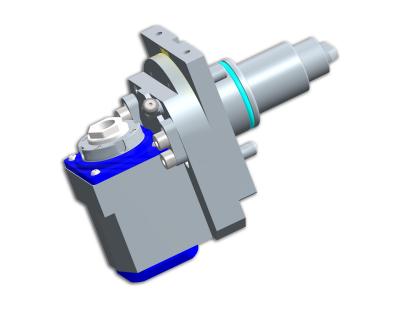
EXSYS Tool’s 90-degree Skiving Drilling and Milling Head not only provides angled drilling and milling capabilities on turning centers, but also enables the machines to perform gear skiving operations. The new head cuts gear patterns faster than conventional gear shaping or broaching methods and generates both internal and external gears with helical profiles, as well as gears close to part shoulders without interference.
With conventional live tooling, cutting tools on turning centers can machine parts only from a horizontal position. Thus, the gear skiving operation would require either a dedicated gear skiving machine or a full 5-axis milling and turning machine. EXSYS’s innovative drilling and milling head enables shops to achieve the angled positions necessary for gear skiving and for the creation of integral splines.
The new drilling and milling head operates at spindle speeds of 3,000 rpm and delivers a torque output of 40 Nm. It is also compatible with external coolant supplies.
On the Skiving Drilling and Milling Head, set screws adjust head position 45 degrees up or down for the system’s full 90-degree range of motion. An operator loosens the set screws, manually sets the position of the head and tightens the screws.
The adjustable head is a stand-alone tooling solution and is also PRECI-FLEX ready. The PRECI-FLEX modular tooling system offers fast, accurate turning machine turret tooling changeovers. The system features a single-base holder and multiple tooling adapters that bring endless possibilities to shops in search of an easy way to boost productivity.
While the short, compact design of the PRECI-FLEX enhances torque transmission and rigidity, its conical and flat-face planar interface provides high levels of accuracy and rigidity when using an adapter or a standard ER collet. The interface also makes it easy to mount collets, endmill holders, expanding collet chucks and shrink-fit tooling to the single-base holder.
Contact Details
Related Glossary Terms
- broaching
broaching
Operation in which a cutter progressively enlarges a slot or hole or shapes a workpiece exterior. Low teeth start the cut, intermediate teeth remove the majority of the material and high teeth finish the task. Broaching can be a one-step operation, as opposed to milling and slotting, which require repeated passes. Typically, however, broaching also involves multiple passes.
- centers
centers
Cone-shaped pins that support a workpiece by one or two ends during machining. The centers fit into holes drilled in the workpiece ends. Centers that turn with the workpiece are called “live” centers; those that do not are called “dead” centers.
- collet
collet
Flexible-sided device that secures a tool or workpiece. Similar in function to a chuck, but can accommodate only a narrow size range. Typically provides greater gripping force and precision than a chuck. See chuck.
- coolant
coolant
Fluid that reduces temperature buildup at the tool/workpiece interface during machining. Normally takes the form of a liquid such as soluble or chemical mixtures (semisynthetic, synthetic) but can be pressurized air or other gas. Because of water’s ability to absorb great quantities of heat, it is widely used as a coolant and vehicle for various cutting compounds, with the water-to-compound ratio varying with the machining task. See cutting fluid; semisynthetic cutting fluid; soluble-oil cutting fluid; synthetic cutting fluid.
- endmill
endmill
Milling cutter held by its shank that cuts on its periphery and, if so configured, on its free end. Takes a variety of shapes (single- and double-end, roughing, ballnose and cup-end) and sizes (stub, medium, long and extra-long). Also comes with differing numbers of flutes.
- gang cutting ( milling)
gang cutting ( milling)
Machining with several cutters mounted on a single arbor, generally for simultaneous cutting.
- milling
milling
Machining operation in which metal or other material is removed by applying power to a rotating cutter. In vertical milling, the cutting tool is mounted vertically on the spindle. In horizontal milling, the cutting tool is mounted horizontally, either directly on the spindle or on an arbor. Horizontal milling is further broken down into conventional milling, where the cutter rotates opposite the direction of feed, or “up” into the workpiece; and climb milling, where the cutter rotates in the direction of feed, or “down” into the workpiece. Milling operations include plane or surface milling, endmilling, facemilling, angle milling, form milling and profiling.
- modular tooling
modular tooling
1. Tooling system comprised of standardized tools and toolholders. 2. Devices that allow rapid mounting and replacement of tools. Commonly used with carousel toolchangers and other computerized machining operations. See toolchanger; toolholder.
- shaping
shaping
Using a shaper primarily to produce flat surfaces in horizontal, vertical or angular planes. It can also include the machining of curved surfaces, helixes, serrations and special work involving odd and irregular shapes. Often used for prototype or short-run manufacturing to eliminate the need for expensive special tooling or processes.
- turning
turning
Workpiece is held in a chuck, mounted on a face plate or secured between centers and rotated while a cutting tool, normally a single-point tool, is fed into it along its periphery or across its end or face. Takes the form of straight turning (cutting along the periphery of the workpiece); taper turning (creating a taper); step turning (turning different-size diameters on the same work); chamfering (beveling an edge or shoulder); facing (cutting on an end); turning threads (usually external but can be internal); roughing (high-volume metal removal); and finishing (final light cuts). Performed on lathes, turning centers, chucking machines, automatic screw machines and similar machines.
- turning machine
turning machine
Any machine that rotates a workpiece while feeding a cutting tool into it. See lathe.

